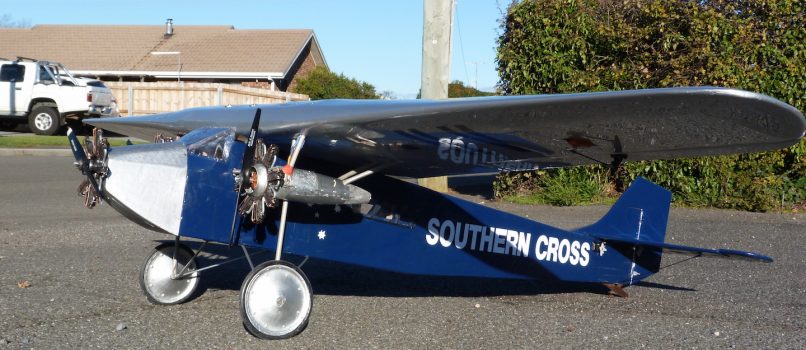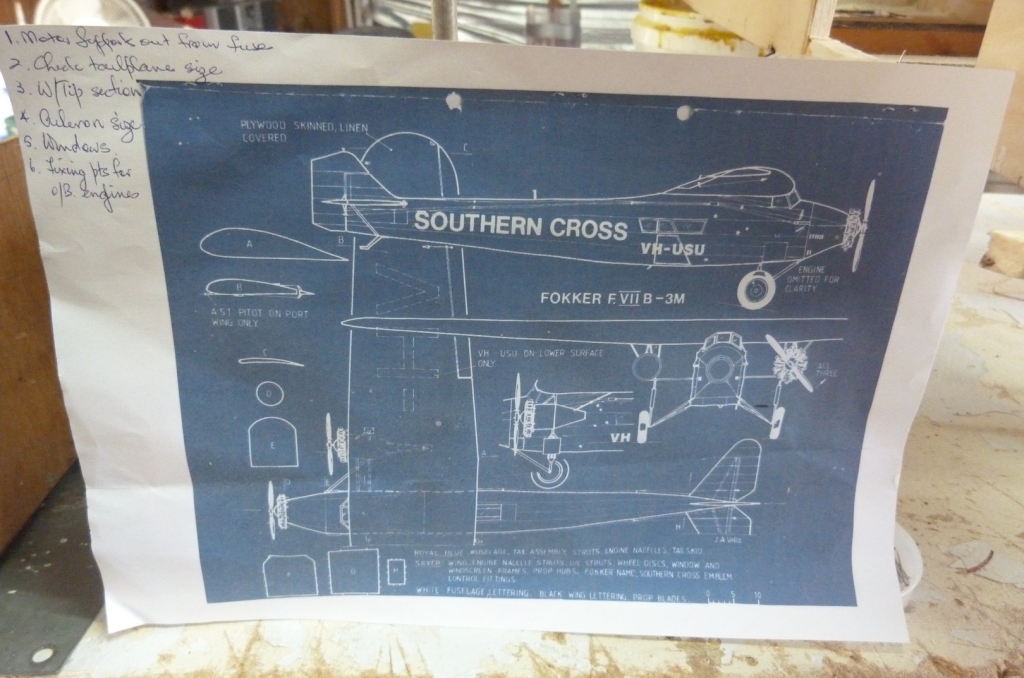There was limited activity around the club this month, mainly due to inclement weather. Unfortunately this was also true for our club day (at least it was in the morning). However, a few of the boys went south on our club day and visited RFAM where an IMAC event was being held (Report below). It is hoped that future events are not held on our club day as no doubt it will have an impact on our club day attendance. Here are a few snippets received from our members.
May 28 – Fokker Trimotor – aka “Southern Cross”.
Our regular builders “Doc” Baldock and Peter Daniel, who are very supportive members of the web site, are at it again. Didn’t I just write up an article last month on another new build? Seems they no sooner finish one and another is underway! Thankfully, they send the build information and photos through to me so that I can spread the word and keep the website active. I know there are many other builders out there but alas none seem to find the time like Peter and Doc to send any photos or build details to ensure the website is kept alive.
This time they have built another monster, a 108″ Fokker Trimotor “Southern Cross”. Scratch built of course and all drawn up from 3D drawings that “Doc” has. “Doc” draws up the build plans and he and Peter set to building the model. Note that all the hardware and wheels etc. have all been hand made by Doc and Peter.
Details
- Fokker F.VIIb/3m
- Wingspan: 108″
- Power: 3 x 48/35 Turnigy motors
- Batteries: 2 x 4s 5000mAh
- Props: 12×8 master Airscrew
Peter sent this email through on May 28.
Hello George,
Steve and I have now finished the Southern Cross. We hope to maiden it on Wednesday (June 1) as the weather is looking pretty good at the moment. She has a 108” wingspan with 3 x 48/35 outrunners spinning 12×8 props powered by 2x 5000 mha 4 cell batteries. If these aren’t powerful enough I think we can go to 5 cell batteries which should be heaps of power but would be reaching maximum on the 60 amp esc’s so we will just wait and see. Doc and I have manufactured all the hardware wheels etc ourselves…. Hope they work !!!!!
Regards,
Peter D.
Peter has kindly sent through these images.
A little bit about the full size Fokker –
Design and development
The F.VII was designed as a single-engined transport aircraft by Walter Rethel. Five examples of this model were built for the Dutch airline KLM. One of these planes, registered H-NACC, was used in 1924 for the first flight from the Netherlands to the Dutch East Indies. In 1925, while living in the US, Anthony Fokker heard of the inaugural Ford Reliability Tour, which was proposed as a competition for transport aircraft. Fokker had the company’s head designer, Reinhold Platz, convert a single-engined F.VII A airliner (a 1924 Walter Rethel design) to a trimotor configuration, powered by 200 hp Wright Whirlwind radial engines. The resulting aircraft was designated the Fokker F.VII A/3M. Following shipment to the US, it won the Ford Reliability Tour in late 1925. The Trimotor’s structure consisted of a fabric-covered steel-tube fuselage and a plywood-skinned wooden wing.
The Fokker F.VII B/3M had a slightly increased wing area over the A/3M, with power increased to 220 hp per engine, while the F.10 was slightly enlarged, carrying 12 passengers in an enclosed cabin. The aircraft became popularly known as the Fokker Trimotor.
Operational history
The eight- to 12-passenger Fokker was the aircraft of choice for many early airlines, both in Europe and the Americas. Along with the similar Ford Trimotor, itself having an all-metal design based on the World War I aircraft designs of German engineer Hugo Junkers, it dominated the American market in the late 1920s. However, the popularity of the Fokker quickly came to an end after the 1931 death of Notre Dame football coach Knute Rockne in the crash of TWA Flight 599, a Fokker F.10. The subsequent investigation, which revealed problems with the Fokker’s plywood-laminate construction, resulted in the temporary banning of the aircraft from commercial flights, more stringent requirements for its maintenance, and the rise of all-metal aircraft such as the Boeing 247 and Douglas DC-2.
Sir Charles Kingsford Smith’s F.VIIb/3m Southern Cross was the first aircraft to cross the Pacific from the United States to Australia in June 1928, and the first to cross the Tasman Sea, flying from Australia to New Zealand and back in September of that year.
Amelia Earhart became the first woman to fly across the Atlantic on 17 June 1928, as a passenger aboard the Fokker F.VIIb/3m Friendship.
May 7, – RFAM – IMAC event.
Will Deal sent through the following email and some photos (Thanks Will!!)-
Hi George,
Just a few snaps from our event last Saturday, the weather was great and a top day all round.
You will note our newly seeded cross strip in background of photo 302……now enjoying the rain.
Tony Gray is missing from the group photo……..he was still eating at the BBQ….true!
Terry, Kev & Merv C attended with Terry 3rd in Basic and Kev 2nd in Advanced
Best regards,
Will
Congratulations to Kevin & Terry.




